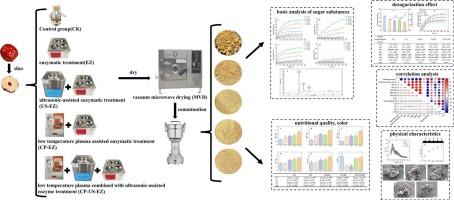Effect of cold plasma synergistic ultrasound-assisted enzyme treatment on the improvement of hygroscopicity and quality characteristics of jujube powder
IF 9.7
1区 化学
Q1 ACOUSTICS
引用次数: 0
Abstract
This study aimed to obtain high-quality jujube powder by reducing its hygroscopicity and tendency to agglomerate. Jujube slices were pretreated with enzyme treatment (EZ), ultrasound-assisted enzyme treatment (US-EZ), cold plasma-assisted enzyme treatment (CP-EZ), and a combined cold plasma synergistic ultrasound-assisted enzyme treatment (CP-US-EZ) prior to vacuum microwave drying (MVD). Given that glucose and fructose are key contributors to hygroscopicity and caking, the impact of each pretreatment on the desugarization effect, nutritional quality, and physical properties of the resulting powder was evaluated. All four pretreatments effectively reduced sugar levels and decreased the agglomeration phenomenon, with CP-US-EZ showing the most pronounced effect. Structural analysis via scanning electron microscopy (SEM) and X-ray diffraction revealed that CP and US modified the powder microstructure, promoting the formation of microporous, spongy textures that facilitated sugar removal and slowed down the hygroscopicity. CP-US-EZ-treated powder exhibited the lowest hygroscopicity and highest contact angle, indicating enhanced resistance to moisture uptake and hydrophobicity. This group showed the greatest content of total phenolics, flavonoids, vitamin C, antioxidant capacity, and monophenols, including 3,4-dihydroxybenzoic acid, protocatechualdehyde, and rutin. These findings demonstrate that CP-US-EZ is a promising non-thermal pretreatment technology to solve the hygroscopicity problem of the powder and produce high-quality, low-sugar jujube powder.

冷等离子体协同超声辅助酶处理对改善红枣粉吸湿性和品质特性的影响
本研究旨在通过降低红枣粉的吸湿性和结块倾向来获得优质的红枣粉。采用酶处理(EZ)、超声辅助酶处理(US-EZ)、冷等离子辅助酶处理(CP-EZ)和冷等离子协同超声辅助酶处理(CP-US-EZ)对红枣片进行真空微波干燥(MVD)前预处理。考虑到葡萄糖和果糖是吸湿性和结块的关键因素,我们评估了每种预处理对所得粉末的糖化效果、营养品质和物理性能的影响。四种预处理均能有效降低糖含量,减少结块现象,其中CP-US-EZ的效果最为显著。通过扫描电镜(SEM)和x射线衍射分析发现,CP和US修饰了粉末的微观结构,促进了微孔和海绵状结构的形成,有利于脱糖,减缓了吸湿性。cp - us - ez处理的粉末吸湿性最低,接触角最高,表明其抗吸湿性和疏水性增强。总酚类物质、黄酮类、维生素C含量最高,抗氧化能力最强,单酚类物质包括3,4-二羟基苯甲酸、原儿茶醛和芦丁含量最高。以上结果表明,CP-US-EZ是一种很有前途的非热预处理技术,可以解决红枣粉的吸湿性问题,生产出高品质、低糖的红枣粉。
本文章由计算机程序翻译,如有差异,请以英文原文为准。
求助全文
约1分钟内获得全文
求助全文
来源期刊

Ultrasonics Sonochemistry
化学-化学综合
CiteScore
15.80
自引率
11.90%
发文量
361
审稿时长
59 days
期刊介绍:
Ultrasonics Sonochemistry stands as a premier international journal dedicated to the publication of high-quality research articles primarily focusing on chemical reactions and reactors induced by ultrasonic waves, known as sonochemistry. Beyond chemical reactions, the journal also welcomes contributions related to cavitation-induced events and processing, including sonoluminescence, and the transformation of materials on chemical, physical, and biological levels.
Since its inception in 1994, Ultrasonics Sonochemistry has consistently maintained a top ranking in the "Acoustics" category, reflecting its esteemed reputation in the field. The journal publishes exceptional papers covering various areas of ultrasonics and sonochemistry. Its contributions are highly regarded by both academia and industry stakeholders, demonstrating its relevance and impact in advancing research and innovation.
 求助内容:
求助内容: 应助结果提醒方式:
应助结果提醒方式:


